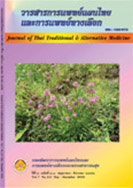Risk Assessment of Arsenic Consumed in Commercial Herbal Tea Sachets
Main Article Content
Abstract
Nowadays, consumption of herbal tea has become very popular among Thai people since it is believed that drinking herbal tea is good for health. However, some herbal raw materials used in the manufacture of
herbal tea may be contaminated with toxic elements such as arsenic. The main objective of the study was to determine the risk of arsenic contamination in eight kinds of herbal tea sachets, namely, rosella tea, Cassia
alata tea, safflower tea, ginger tea, Morus alba tea, senna tea, Thunbergia laurifolia tea and Orthosiphon aristatus tea. The procedures of the study comprised both a survey of herbal tea consumption in Thai people and a
quantitative determination of arsenic content in herbal tea sachets. A survey of herbal tea consumption in Thai people was carried out by using a questionnaire. The total arsenic and inorganic arsenic in the selected
herbal tea sachets was quantitatively determined by using atomic absorption spectrophotometry. The risk assessment described in terms of hazard quotient (HQ) and cancer risk (CR) was calculated using both deterministic
and probabilistic risk assessment. As a result, both HQ and CR values of risk assessment for arsenic contamination in eight kinds of herbal tea sachets remained within acceptance criteria. For probabilistic risk
assessment by @RISK® software, the cancer risk values were 1 to 8 in 10,000,000. Generally, the criteria of cancer risk value should not exceed 1 in 1,000,000. From this study, it can be concluded that the consumption
of the eight herbal tea sachets does not put one at risk of developing cancer as a result of arsenic intake.
Article Details
References
2. Arsenic Compounds. [cited 2008 February 4]. Available from: https:// www.epa.gov/safewater/arsenic/index.html.
3. Piampongsant T. Chronic environmental arsenic poisoning. Int J Dermatol 1999;38:401-10.
4. Yuan C, Gao E, He B, Jiang G. Arsenic species and leaching characters in tea (Camellia sinensis). Food Chem Toxicol 2007;45:2381-9.
5. Supplement to Thai Herbal Pharmacopoeia. 2nd Ed. Bangkok: Prachachon Co., Ltd; 2007. p. 5.
6. USEPA. Risk characterization handbook. Science Policy Council. US Environmental Protection Agency. USEPA 100-B-00-002. Washington, DC. , USA; 2000.
7. USEPA. Exposure Factors Handbook. US Environmental Protection Agency. USEPA/600/8-89/043. Washington, D.C. USA; 1997a.
8. Bodenseework Perkin-Elmer GmbH. The THGA graphite furnace: techniques and recommended conditions. Federal Rapublic of Germany: Ueberlingen; 1991.
9. Munoz O, Velez D, Montoro R. Optimization of the solubilization, extraction and determination of inorganic arsenic [As(III) (As(V)] in seafood products by acid digestion, solvent extraction and hydride generation atomic absorption spectrometry. Analyst 1999;124:601-7.
10. USEPA. Guiding principles for Monte Carlo analysis. Office of Research and development, Risk Assessment Forum. USEPA/630/R-97/001.Washington, DC. USA; 1997b.
11. Palisade Co. Guide to Using @RISK Risk Analysis and Simulation Add- In for Microsoft® ExcelVersion 4.5. Palisade Corporation, NY USA;2005.


